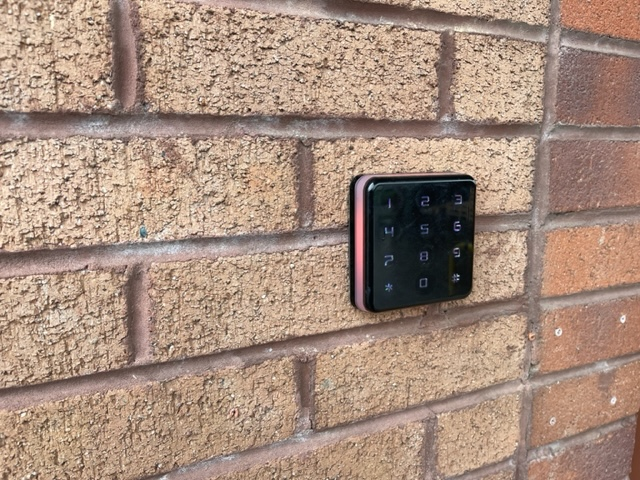Wiegand Compatible Access Control Card Readers
30 March 2023

Along with CCTV cameras, access control card readers and keypads, can be the most visible sign that an organisation takes security seriously.
Card readers are used to control access to external and internal doorways. As well as being robust enough to withstand daily usage, sometimes by hundreds if not thousands of users, access control card readers also need to be highly reliable and secure.
How Access Control Systems Secure Doorways
An access control system consists of access control management software, door controllers, access control cards, and a selection of card readers, keypads, request-to-exit (RTE) buttons and break-glass units.
- Access control management software: this is the intelligent part of the system, with a user database, assigned credentials, logs and reports. Any user wanting to pass through a controlled doorway, will need their user details recorded in the access control database and assigned at least one credential.
- Access Control Door Controllers: these can be one or two door controllers, or catering for a larger number of doorways from four to eight with up to 100 devices across an IP network. Door controllers typically use maglocks to secure doors. These energized or de-energized by the door controller to open or keep closed, the doorway.
- Access Control Cards: carry credentials secure and are presented to card readers to gain entry or exit through a controlled doorway.
- Access Control Card Readers: read access control cards. Single factor authentication relies on the card credential information. A reader may also have a built-in keypad for PIN-entry to provide multifactor authentication i.e., card and PIN or PIC. Readers are normally placed either side of a controlled doorway or have one on the entrance and an RTE on the exit.
- Request-to-Exit (RTE) Buttons: these are used in place of access control cards where a person can walk through without having to present their card. A simple push-button instructs the door controller (via the management software) to open the door. Contactless RTEs are available where a person simply has to hold their hand within a few millimeters of the RTE.
- Break Glass Units (BGUs): provide a means to bypass an access-controlled doorway in an emergency situation. They are emergency door releases to be used during for example a fire.
When it comes to card readers or combined card reader/keypads most access control manufacturer rely on the Weigand interface between these are their door controllers. This has an added benefit for access control manufacturers, installers and users. A Weigand compatible reader should work with any Weigand compatible access control system, allowing the most suitable readers to be installed for an installation.
What is a Weigand Interface?
Wiegand is an interface protocol used to communicate data between a card (credential) and a card reader, and between a card reader and door controller. Weigand is the most commonly used protocol in access control applications. A Wiegand interface comprises of three wires, two act as data transmission wires and the third as a common ground. As the wires are embedded in the access control and store information and are made from magnetic material that is hard to duplicate.
The Remsdaq Weigand Card Reader Range
As part of the Entro range of access control systems, Remsdaq design and manufacture a range of card readers, card reader keypads and contactless request to exit (RTE) buttons.
- EntroPad Card Readers and Keypads: EntroPad can be used with any Wiegand compatible access control system, including other leading brand manufacturers. The device can function as a smart 13.56MHz card reader for MIFARE and EntroClass Secure cards. The LED colours can be used to match local building décor and status and include: red, blue, green, amber, magenta, cyan, yellow and white. Keypad versions are available with English or Arabic numerals. Built-in antimicrobial protection can also help to prevent bacterial and virus spreading.
- EntroPad RTE: the EntroPad Request to Exit (RTE) button is a contactless solution that can help to prevent accidental damage and provide a more hygienic solution for door exit. Simply present a hand to the RTE and the device signals the connected door controller to open the door. The colour of the LED outer band and hand symbol is settable and can differ to represent standby or active states.
Other Entro series access control system products available include:
- Desktop Enrolment Readers: EntroPad desktop readers provide straightforward registration of card credentials within EntroWatch software.
- Reader Management Kits: EntroPad management kits provide an easy way to customise individual EntroPad readers around a building.
- EntroPass Secure Credentials: a MIFARE Plus secure credential for use with EntroPad readers and available in either card or key fob format.
Card readers and keypads with a Wiegand interface are the most commonly installed type in access control systems. The Remsdaq Entropad range offers a number of benefits including contactless and built-in antimicrobial protection, settable LED colour combinations and the highest levels of security and reliability. Whilst designed as part of the Entro series range, EntroPad card readers, keypads and RTEs can be used with any access control system with a Wiegand compatible connection.
